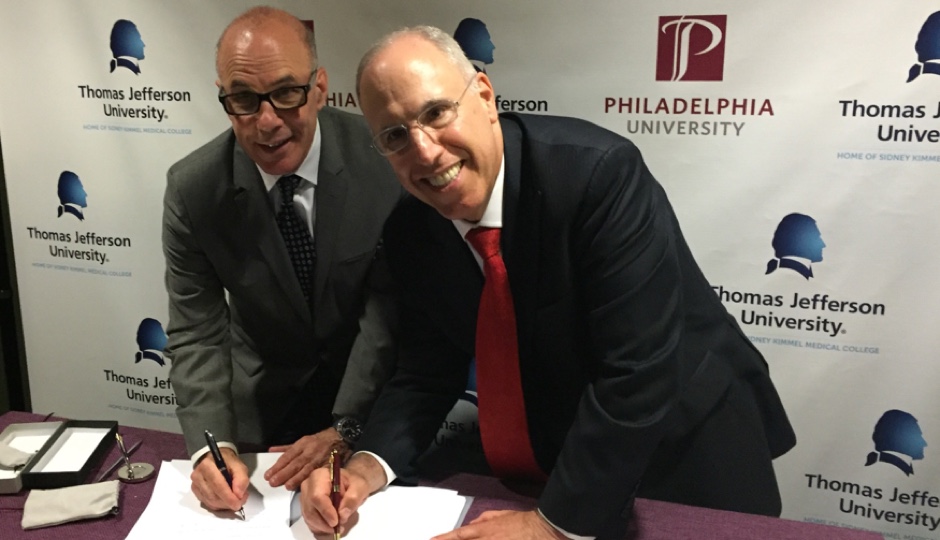Thomas Jefferson and Philadelphia Universities to Combine in 2017
It’s official: Thomas Jefferson University and Philadelphia University will become one institution in 2017, making the combined school the fifth-largest university in Philadelphia.
The two long-standing Philadelphia schools entered into a combination agreement on Friday months after they announced their intent to merge at the end of 2015. And now, the combined school — whose name has not been finalized — is positioned to “revolutionize higher education,” an ambitious goal of the agreement.
The two universities couldn’t be more dissimilar on paper: Thomas Jefferson University, with its campus stretched throughout Center City, has been a trailblazer in the health sciences for 200 years; Philadelphia University, almost as old as Jefferson, sits on a bucolic site in East Falls, with students mostly specializing in architecture, fashion, and graphic design.
But what powerhouse Stephen Klasko, president and CEO of Thomas Jefferson University and Jefferson Health, and forward-thinking Philadelphia University president Stephen Spinelli have identified is a match that will better prepare students for what they call the jobs of the future.
“It’s the start of a revolution in how students are taught, in how we provide greater value in more customized offerings, and in the recognition that design and healthcare are inextricably linked,” Klasko said in a statement.
He told Philadelphia magazine, “We’re looking at it like we’re creating a brand new university. We’re going to have a startup mentality because the value in academics has gotten so bloated. It’s just this is how we do things and this is how much we charge. But now we want to create a whole new model.”

Dr. Stephen Klasko, president & CEO of Thomas Jefferson University and Jefferson Health, and Dr. Stephen Spinelli, PhilaU president, sign the binding combination agreement to bring the two institutions together as one, comprehensive university in 2017.
Klasko will be president and CEO of the combined university and Jefferson Health, and Spinelli will lead as chancellor in partnership with Mark Tykocinski, executive vice president of academic affairs and dean of the Sidney Kimmel Medical College of Thomas Jefferson University.
“TJU is known for its world-class, inter-disciplinary health education and its pioneering work on healthcare team building. PhilaU is known for Nexus Learning, which brings together active and collaborative learning, connects it to the real world, and infuses it with the liberal arts,” said Tykocinski.
Students at Thomas Jefferson University who might not have studied outside their nursing curriculum, for example, are now encouraged to dabble in design thinking, and students on a fashion design track will now have the opportunity to determine how scientific and applied research, for example, fits in with their work. The new university says it will center itself on professional education, and the unique model will offer insights into the future of education, the future of health and the future of work.
“We’re thinking doctors who are designers, nurses who are managers, designers who are physician assistants, occupational therapists who are industrial designers or who are given education around an interdisciplinary approach,” Spinelli told Philadelphia magazine.
Pending regulatory and accrediting agency approvals, the combined school will boast an enrollment of about 7,500 students (equal parts undergraduate and graduate) and a combined alumni base of 78,000. The institution’s projected enrollment will put it ahead of Villanova University and just short of St. Joseph University‘s enrollment number. “Our goal is to become a campus of 10,000 students with new programs and buildings,” Klasko told Philadelphia magazine, behind Temple, Drexel, and the University of Pennsylvania.
Students will have a mix of suburban and urban campus environment — they’ll travel for classes in Atlantic, Bucks, and Montgomery counties, too.
And for the most efficient transition to the new model, the two universities have commissioned a market research study to inform a cohesive brand strategy and implementation plan that will take into consideration the value and brand of each university. The leaders say that months from now this process will lead them to a thoughtful name that will preserve the character and acclaim of the many colleges currently under each institution.
“The system is broken, and we have to change it.” said Spinelli. “Delivering on a more robust value proposition for students is at the heart of it. We will be an example from which a lot of people can learn. That’s why it’s important we do it right.
Follow @fabiolacineas on Twitter.


